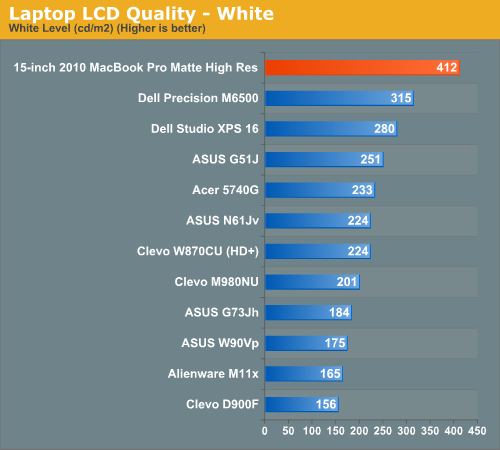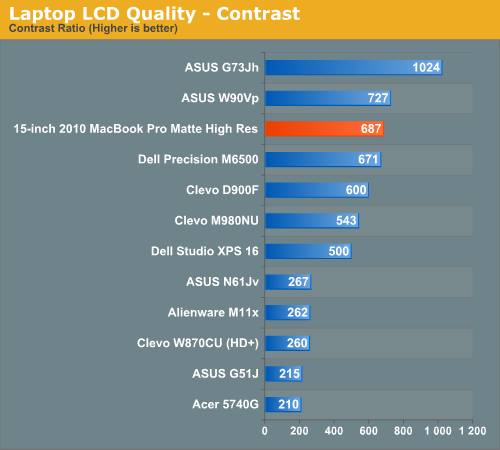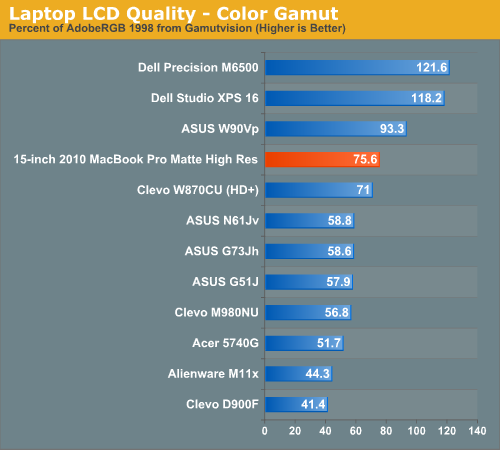Apple's 15-inch 2010 MacBook Pro: More Battery Life Tests, High Res Display Evaluated
by Anand Lal Shimpi on April 24, 2010 1:57 AM EST- Posted in
- Mac
- Displays
- MacBook Pro
- Arrandale
- Laptops
High Resolution, Matte Display: Tested
For creative professionals and digital photography or videography enthusiasts alike, LCD quality of the MacBook Pro is a huge consideration. Luckily, Apple delivers in this department.
Apple thankfully provides matte high resolution display options for both the 15” and 17” MacBook Pros. If you’re partial to glossy displays, there’s also a glossy high resolution display option available online, though it isn’t one of the SKUs that will be stocked in Apple retail stores - you’ll have to order it online.
Since many creative professionals likely will seek the matte option (and because it’s the only high resolution display option available in-store), we chose to do monitor profiling and analysis with this particular model. On the surface, very little has changed, the display itself still substitutes the black glass bezel for an aluminum one. The LCD sits inset from the aluminum bezel about a millimeter, diminishing the chances of your keyboard smudging and scratching up the display like what was so endemic with the pre-unibody design.
| 15-inch 2010 MacBook Pro 6,2 Core i7 | |||
|
Matte High Resolution Display Option
|
|||
| Panel Type | TN (Samsung LTN154MT07) | ||
| Pixel Pitch | 0.197mm | ||
| Viewable Size | 15.4 diagonal | ||
| Resolution | 1680 x 1050 (WSXGA+) | ||
| Screen Treatment | Matte (anti-glare) | ||
The first thing that strikes you about the 2010 MacBook Pro LCD is how bright it is. As we’ll show in a minute, it’s the brightest LCD we’ve tested, thanks in part to its WLED backlighting. While the color gamut is only above average, Delta E tracking is also very good.
For these tests, we used ColorEyes Display Pro with an X-Rite Eye-One Display 2 colorimeter. I originally tested at maximum brightness, and then at precisely 200 nits of luminance. The black level down below is given at maximum brightness. Interestingly enough, Delta E tracking and color accuracy remains largely the same at both settings.
Another note I’ll leave you with is that although using a calibration tool is still an absolute must for the best monitor performance, Apple’s display profile that ships with OS X is surprisingly good. Out of box, the display’s white point was almost exactly 6500K, and the LUT curves subjectively nearly matched those that eventually resulted after calibration. Color tracking and Delta E weren’t good, but subjectively the display looked good.





The LED backlight Apple uses in the display still isn’t RGB LED, so color gamut isn’t anything spectacular, but it isn’t bad either. Performance is average, but what we get is both expected and pretty good for this class of LED backlit notebook displays.


Display uniformity is very good; there is virtually no distracting light leakage from any of the displays. In addition, black level is very good throughout. The viewing angles remain largely what you’d expect from any TN panel in its class. There isn’t an overwhelming amount of color shift when viewing the monitor at horizontal angles. Vertical is another story - there’s a tight range of vertical angles over which the color shift is negligible.
The performance we get with the MacBook Pro’s display is very good - but it still could be better. Among WLED backlit, TN packing notebook LCDs, it certainly shines out as one of the best options. That said, there’s no reason this “Pro” notebook shouldn’t see RGB LED backlighting and potentially even an IPS panel as options soon. Enthusiasts and professionals are more than willing to shell out the cash for large gamut LCDs on the desktop - why not on the notebook? It’s obvious that Apple isn’t averse to IPS panels, especially considering the iPad.
















69 Comments
View All Comments
ltcommanderdata - Saturday, April 24, 2010 - link
It's kind of disappointing that the Core i7 takes a noticeable battery life hit compared to the Core i5 considering they both in the same 35W TDP target. Could you double check the clock speeds of the GPU in the Core i7 model? The low-end Core i5 model you previously showed a GPU-Z shot of was definitely underclocked, but perhaps that's because it's replacing the previous pure 9400M model, whereas higher model MacBook Pros might have higher clock speeds which could help explain the battery life difference.As well, since you have Windows installed on the MacBook Pros, could you do your round of mid-range laptop gaming comparison benchmarks as was done for the ASUS G73Jh? People don't buy MacBook Pros specifically to game, but people with MacBook Pros no doubt do play games, so I think it'll be useful information. Running it against the Mid-2009 17" MacBook Pro you have would also be good to see the improvement of the GT330M over the 9600M GT.
I'm also curious to see if the limited thermal room of the MacBook Pro limits the effectiveness of Turbo Boost. It might be interesting to chart the CPU frequency of the Core i7 over an hour as it cycles through an intensive benchmark to see if it can hit the top Turbo Boost bin (3 bins for 2 cores) and how long it can sustain that before the heat sinks saturate and the clock drops back down to normal. Of course, without comparison to other laptops with more thermal room, it's hard to tell the "normal" or optimal Turbo Boost behaviour of the Core i7, but it should be something manufacturers should consider to differentiate themselves from others using the same components.
aj28 - Saturday, April 24, 2010 - link
Anand,Pardon if you've already covered this and I missed it, but have you done any tests comparing the effects on battery life by the use of Flash 10.1 versus Flash 10.0 on any of the Apple/Optimus GPU-switching i5/i7 notebooks? If Flash 10.1 kicks on the dGPU, is there a chance that the i5 might be able to power through it with ease to the point that you could actually get better battery life by not using GPU acceleration?
I know that goes against common wisdom, and I'm sure you would be better off if we were talking about a low-power integrated chip, but it seems to me that the mid-to-high-end dGPU chips are horribly inefficient for this type of thing in cases like these where they can, unlike a desktop, simply be switched off completely in favor of an iGPU which has to be powered all the time anyway, even if in a low-power state.
Thanks for your reply if you get around to it!
flgt - Saturday, April 24, 2010 - link
I think you've already stated why they won't put much effort in OS X. It's a huge population of STUDENTS. And students don't generate revenue like fat corporate and government accounts.I’m sure the Mathworks don’t want to artificially limit their customer base, but if it is coming down to a decision between OS X or Windows/Linux it’s obvious which one will take priority.
For the vast amount of companies Windows and Linux deliver equivalent or better hardware at much better price points. They also host more of the client applications that drive productivity, which could be argued to be more important than the OS itself.
You could argue it is important to reach students who one day might be paying corporate users, but if a student learns MATLAB on their Mac they can easily be just as productive on a corporate PC. There is no real incentive to make the experience better for a minority of non-paying users.
mbene12 - Sunday, April 25, 2010 - link
I know it is totally off topic, but this is exactly why I left Matlab for python. Their lack of native Mac support. As I transitioned from student to professional I just didnt see a reason to pay $4000 a year for base license and libraries which performed poorly when I could get most of what I needed done in a mix of Python and C for free.erple2 - Monday, April 26, 2010 - link
I think that thinking is a double edged sword. Students (and more importantly, Universities) are a major piece of the Matlab licensing revenue. I know that the Educational discount is pretty decent, but that's still a significant chunk of change. I'd wager that if you looked at the total number of licenses the Mathworks distribute, Education would be an even player with Corporate and Government levels.The other argument (that you can get more hardware for the money) has (almost) always been the case with Apple, however. There were a few notable exceptions (Apple had the first Core2 based desktops and laptops - I can't remember if they were on the forefront with the i7 based desktops, though), plus when DDR3 first came out in a SODIMM format, Apple was curiously reasonably priced.
rawd - Saturday, April 24, 2010 - link
Hi Anand, Cody Kreiger on Macrumors has already written an app to monitor GPU usage and it resides in the taskbarhttp://codykrieger.com/gfxCardStatus.app.zip
bitninja - Saturday, April 24, 2010 - link
Thanks for the mention rawd! Anyone interested in seeing the MacRumors forum thread where it's being discussed and fleshed out can visit it below until I get a formal page up on my website:http://forums.macrumors.com/showthread.php?t=90152...
Thanks, be sure to leave a comment with your thoughts if you try it out!
Cody
rcocchiararo - Saturday, April 24, 2010 - link
Is it posible to get a 15 inches macbook pro with a glossy/matte high res display from, lets say.. amazon/bestbuy/newegg/whatever ?or only directly from apple ?
Computer Scooter Joe - Saturday, April 24, 2010 - link
Thanks for the info, just one more question. Do the fans spin up as a result of the dGPU being on? Or are they generally fairly quiet?I understand that it depends on the application, but im talking about just idiling at desktop or web browsing or working in Word.
maxxl - Saturday, April 24, 2010 - link
I can't post this command here unfortunately, becouse of an error that appears when I try to, so look at this thread for "ioreg -lw0" command:http://discussions.info.apple.com/message.jspa?mes...
With the model number you can find manufacturer easily, i.e. here:
http://www.beyondinfinite.com/library.html
Best reards,
Max